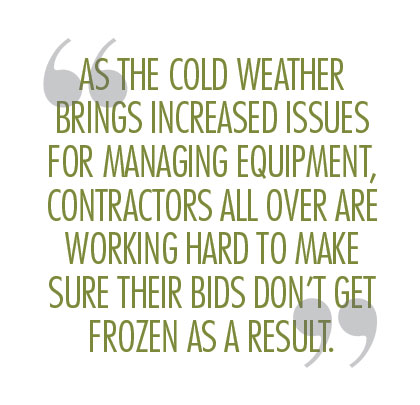Construction executives know that equipment utilization can be the key competitive differentiator. On competitive jobs, you might make 10 percent margin for the business if you’re lucky. However, many firms have more than a 10 percent margin of error on their bid. Unfortunately, this means that the margin of error can erase the entire profit margin for the job.
Not to be a grinch, but this is especially true in the winter months. The site foreman may set up a haul in the morning, see excellent haul times, then leave and go handle other work throughout the day. When they get back the next morning they find the haul productivity plummeted by 70 percent. It may take a few days of deep diving to realize that there was a patch of haul road that was frozen in the morning but thawed out by the afternoon, and trucks were getting stuck in the return haul.
To make things more complicated, incentives are not always aligned for subcontractors to provide accurate information on equipment utilization. There can be a gaming of the actual progress reporting by under-loading each truck and reporting more hauls. If that’s the case, then a firm may end up writing off some of this supposed gain at the end of the year and the end of the project.
KNOW THE NUMBERS
Opacity in progress reporting also can have a severe effect on cash flow. All contractors know that cash flow can be a matter of life and death for a company. Contractors also know that if they bill too much up front they risk operating the last quarter of the project with no incoming cash flow. However, billing too slowly means the company is stressed for cash to make critical payments on equipment leases, personnel, and general and administrative (G&A) expenses. Since cash flow is crucial, especially when running a construction firm, smart executives focus on ways to smooth the cash flow out as much as possible.
That situation can also have a snowball effect because if actual equipment utilization rates are unclear it can restrict the ability to put in competitive bids on the next project. Without knowing actual costs down to the percent, contractors cannot confidently put in competitive bids. Some firms think they are “buying business” by bidding at a 3 percent margin, but end up way underbidding and losing money on the project. Some firms think they are putting in a profitable 20 percent margin on a bid, but end up way overpricing it and completely missing out on the project altogether.
KNOW YOUR RATES
Equipment is just a commodity, but the ability to deploy it and manage it effectively is the differentiated strategic advantage. It can mean the difference between life and death for firms. Winter is really setting in now and people are taking stock of their final equipment utilization rates for the past year. It might be time to think about how your firm arrived at your bid item rates this year, and think about how you’re going to improve them for next year.
SMART TRACKING TREND
One major trend in the equipment industry is smart tracking through sensors. This is commonly referred to as the Internet of Things (IoT). Every piece of equipment can hold a sensor, which can now work as more than just a GPS. Our excavation management tool combines a sensor on a truck with software to help excavation and aggregate companies manage fleets related to earthmoving. Other companies put sensors on hard hats or work boots. The data captured through these sensors is valuable on its own but combined with data from other sources, like a drone, or BIM, the results can be even more useful.
As the cold weather brings increased issues for managing equipment, contractors all over are working hard to make sure their bids don’t get frozen as a result.
About the Author:
Dick Zhang is president and CEO of Pittsburgh, Pennsylvania-based Identified Technologies, where he leads the rapidly growing team’s efforts to deliver real-time jobsite updates to industry leaders with their managed commercial drone solution. For more information about Identified Technologies, visit www.identifiedtech.com.
_________________________________________________________________________
Modern Contractor Solutions, January 2018
Did you enjoy this article?
Subscribe to the FREE Digital Edition of Modern Contractor Solutions magazine.




